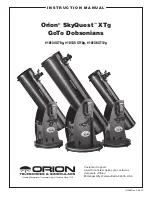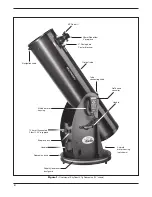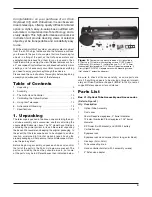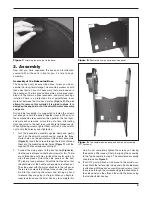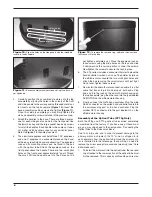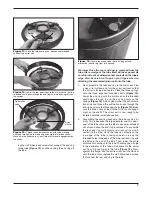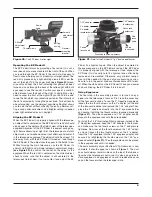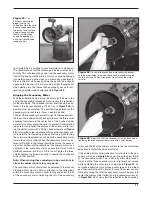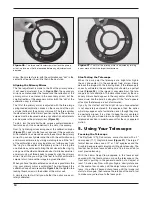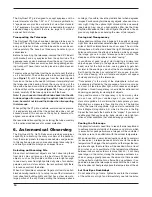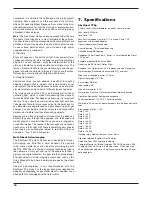
15
galaxies, and star clusters – or even very many stars, for
that matter. Your eyes take about 30 minutes to reach per-
haps 80% of their full dark-adapted sensitivity. Many observ-
ers notice improvements after several hours of total darkness.
As your eyes become dark-adapted, more stars will glimmer
into view and you will be able to see fainter details in objects
you view in your telescope. Exposing your eyes to very bright
daylight for extended periods of time can adversely affect your
night vision for days. So give yourself at least a little while to
get used to the dark before you begin observing.
To see what you are doing in the darkness, use a red-filtered
flashlight rather than a white light. Red light does not spoil
your eyes’ dark adaptation like white light does. A flashlight
with a red LED light is ideal. Dim light is preferable to bright
light.
Be aware, too, that nearby porch and streetlights and auto-
mobile headlights will spoil your night vision. Close your eyes
when you hear an automobile approaching your observing
site!
Eyepiece selection
By using eyepieces of different focal lengths, it is possible
to attain many different magnifications with your telescope.
Different eyepieces can be used to achieve higher or lower
powers. It is quite common for an observer to own five or
more eyepieces to access a wide range of magnifications.
This allows the observer to choose the best eyepiece to use
depending on the object being viewed. At least to begin with,
the two supplied eyepieces will suffice nicely.
Whatever you choose to view, always start by inserting your
lowest-power (longest focal length) eyepiece to locate and
center the object. Low magnification yields a wide field of
view, which shows a larger area of sky in the eyepiece. This
makes acquiring and centering an object much easier. If you
try to find and center objects with high power (narrow field
of view), it’s like trying to find a needle in a haystack! Once
you’ve centered the object in the eyepiece, you can switch
to higher magnification (shorter focal length eyepiece), if you
wish. This is especially recommended for small and bright
objects like planets and double stars. The Moon also takes
higher magnifications well.
Deep sky objects, however, typically look better at medium
or low magnifications. This is because many of them are
quite faint, yet have some extent (apparent width). Deep sky
objects will often disappear at higher magnifications, since
greater magnification inherently yields dimmer images. This
is not the case for all deep sky objects, however. Many galax-
ies are quite small, yet are somewhat bright, so higher power
may show more detail.
The best rule of thumb with eyepiece selection is to start with
a low power, wide field, and then work your way up in magnifi-
cation. If the object looks better, try an even higher magnifica-
tion. If the object looks worse, then back off the magnification
a little by using a lower power eyepiece.
astronomical objects
Now that you are all setup and ready to go, one critical deci-
sion must be made: what to look at?
A. The Moon
With is rocky and cratered surface, the Moon is one of the
most interesting and easy subjects to view with your tele-
scope. The best time to view it is during its partial phases
when shadows fall on the craters and canyon walls to give
them definition. While the full moon may look like a tempting
target, it is not optimal for viewing! The light is too bright and
surface definition is low.
Even at partial phases the Moon is very bright. Use of an
optional Moon filter helps to dim the glare. It simply threads
onto the bottom of the eyepiece. You’ll find the Moon filter
improves viewing comfort, and helps bring out the subtle fea-
tures of the lunar surface.
B. The Sun
You can change your nighttime telescope into a daytime Sun
viewer by installing an optional solar filter over the front open-
ing of the telescope. The primary attraction is sunspots, which
change shape, appearance, and location daily. Sunspots are
directly related to magnetic activity in the Sun. Many observ-
ers like to make drawings of sunspots to monitor how the Sun
is changing from day to day.
Important Note: Do not look at the Sun with any optical
instrument without a professionally made solar filter, or
permanent eye damage could result. Also, be sure to
cover the finder scope, or better yet, remove it altogether.
C. The Planets
The planets don’t stay put like the stars, so to find them you
should refer to Sky Calendar at our website OrionTelescopes.
com, or use the IntelliScope Object Locator. Venus, Mars,
Jupiter, and Saturn are the brightest objects in the sky after
the Sun and the Moon. Your XTg is capable of showing you
these planets in some detail. Other planets may be visible but
will likely appear star-like. Because planets are quite small in
apparent size, optional higher power eyepieces are recom-
mended and often needed for detailed observations. Not all
the planets are generally visible at any one time.
Jupiter: The largest planet, Jupiter, is a great subject for
observation. You can see the disk of the giant planet and
watch the ever-changing positions of its four largest moons:
Io, Callisto, Europa, and Ganymede. Higher power eyepieces
should bring out the cloud bands on the planet’s disk.
Saturn: The ringed planet is a breathtaking sight. The tilt
angle of the rings varies over a period of many years; some-
times they are seen edge-on, while at other times they are
broadside and look like giant “ears” on each side of Saturn’s
disk. A steady atmosphere (good seeing) is necessary for a
good view. Look closely and you may see the Cassini division,
a thin, dark gap in the rings. You should also see one or more
of Saturn’s moons, which look like faint stars. The brightest is
the moon Titan.
Venus: At its brightest, Venus is the most luminous object in
the sky, excluding the Sun and the Moon. It is so bright that

